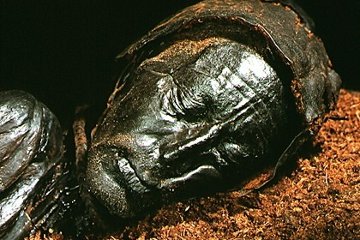Peaty Conditions
Peat is interesting stuff: in plain contradiction of common sense, bogs of it tend to favour the tops of mountains instead of the hollows and valleys; thought by some to be the precursor to coal, it is used by Scottish crofters as a fuel, by gardeners as a fertiliser, and a recent study suggests that iron-rich run-off from peaty highlands fosters phyto-plankton in the oceans which in turn provide nutrition all the way up the food-chain to the fish that humans eat. The removal of vast areas of peat to supply the gardeners of the world has led to dramatic declines in fisheries, such as the sardine harvest in Monterey Bay in California, which vanished in 1952 after coastal peatlands were drained.

| |
| He looks peaceful enough, but Tollund Man's death was violent. |
Peat has also had its part to play in archaeology. Because of the anaerobic conditions in a bog, things thrown into it tend to be preserved, among them a collection of human remains, such as the famous Tollund Man. Although the soft tissues of this unfortunate individual's body have been preserved so well that scientists have been able to identify the contents of his last meal, the slight acidity of the bog water dissolved all his bones so that what was found was a well-tanned leather bag in the shape of a man and containing all a man's internal organs.
Speculation as to Tollund Man's presence in the bog have ranged all the way from religious ritual to chance-met cut-throats. Certainly he did not arrive there by accident: there is a noose about his neck. It is possible, however, that Tacitus, the Roman writer, may preserve the true story of his fate. In his description of Germany Tacitus writes:
The mode of execution varies according to the offence. Traitors and deserters are hanged on trees; cowards, shirkers and sodomites are pressed down under a wicker hurdle into the slimy mud of a bog. This distinction in the punishments is based on the idea that offenders against the state should be made a public example of, whereas deeds of shame should be buried out of men‘s sight.
A couple of years ago peat diggers in Britain found another of these bog bodies, but in this case his killers seem to have been exceedingly anxious to ensure that their victim was well and truly dead. There was evidence of a crushing blow to the head — which alone would have been enough to kill him — after which his throat was cut and then he was strangled with a cord.
Appalled scientists, groping for an explanation of such violence, further noted that this individual, unlike nearly all others, was not thrown naked into the bog but was dressed in rich robes and expensive jewellery, indicating that his killers were not common thieves. Furthermore, his robes and ornaments were of Irish origin. When various dating techniques led them to place his death to around AD 60 the historians suggested that he had been selected (whether voluntarily or not is not known) for sacrifice by chieftans assembled to support the revolt of Boudicca.

| |
| Vast areas of peat bog preserve a record of man's activities. |
William Shotyk and Dominik Weiss of the University of Bern in Switzerland have been investigating another aspect of peat. Moss growing on the surface of the peat is overlaid by the next season's growth and thus gradually buried. During its short life, however, the moss obtains all its nutrients from the air — and along with the good things, a certain amount of whatever else the air contains. The two men have been studying the 20 foot thick Étang de la Gruyère bog in the Jura mountains and have discovered that the moss preserves a record of air pollution since before man entered Europe.
In the very earliest layers, the moss contains .28 parts per million of lead, a ratio that was preserved until the advent of man, apart from a short blip that could be correlated with massive volcanic activity in France. At about the time that historians believe agriculture became widespread in Europe, the concentrations of lead nearly tripled, due, they suggest, to wind-borne dust picked up from newly ploughed fields.
About 1,000 BC the level of lead increased again, probably due to the Phoenicians trading in lead from Spain, lead which had to be smelted down into ingots and was then further worked to produce a range of goods, from clamps that held the Parthenon together to lead water pipes. This level of lead gradually rose as Greek and Roman industry made increasing use of lead, but dropped in the Middle Ages as other metals became more common. The Industrial Revolution brought another dramatic increase that reached a peak in 1905 and fell thereafter as the dangers of lead were recognised. A second peak was reached in 1967, owing to the use of leaded petrol, reaching an all-time high of 85 parts per million. Since then the mosses of the Jura have absorbed less and less lead.
Of course, all this raises the interesting question: how much of human suffering is self-induced? If the natural level of environmental lead is .28 parts per million, and humans are responsible for raising that to nearly three hundred times as much, what effect has that had on the physical, mental and social development of the human race? What has been the effect on public health? And perhaps more importantly, what ought we to do about it?





